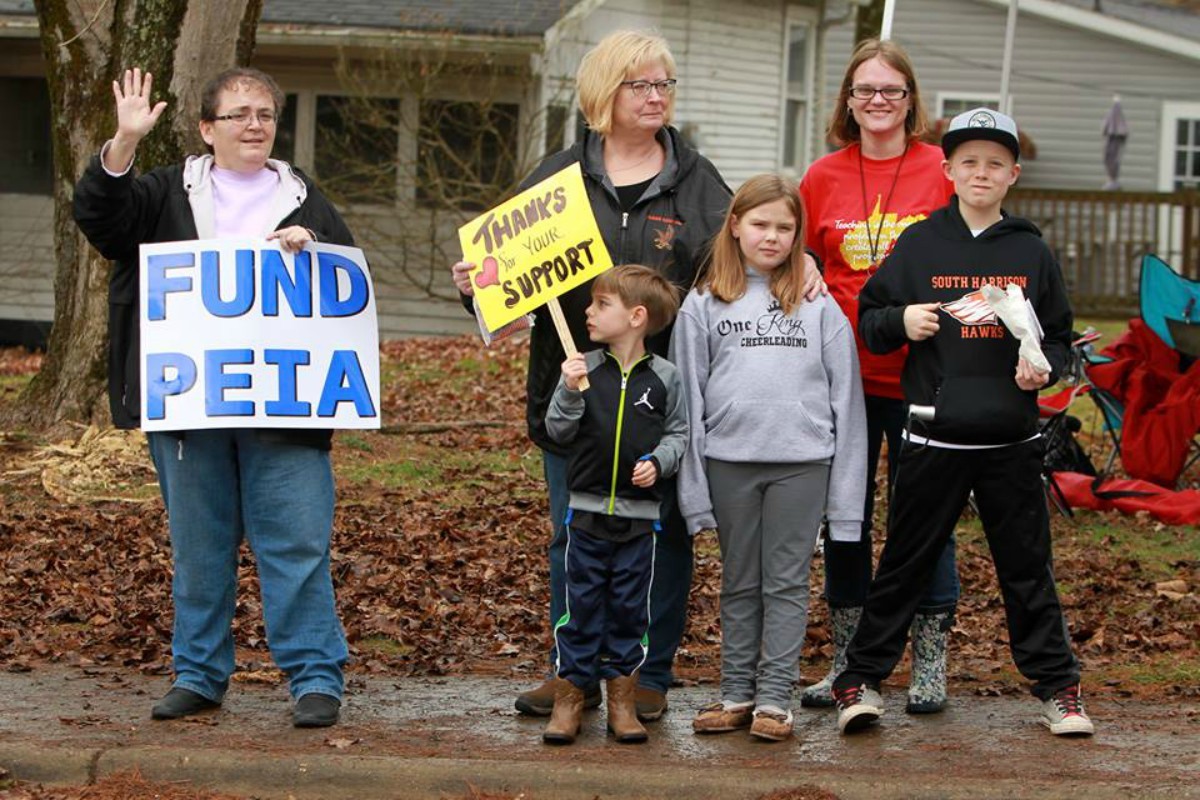Filed under: Audio Report, Featured, Interviews, Labor, Radio/Podcast, Southeast

Podcast: Play in new window | Download
Subscribe: RSS
Photos used with permission from Kyle Mad Jenkins
On Instagram and Twitter
In this audio report we caught up with a teacher in West Virginia who is currently on strike along with tens of thousands of bus drivers and other school employees. Pay for West Virginia teachers is one of the worst in the nation, and workers are also striking to reject the rising costs of heath care through the state-run Public Employees Insurance Agency, or PEIA.
 For the last two days, more than 20,000 workers across the entire state have walked out, taken to picket lines, attended mass rallies, and have also worked to organize free distribution of food to school children impacted by the loss of school meals. Workers also face possible retaliation for the strike, as the State has declared the strike illegal and threatened strikers with injunctions, fines, and even jail time. More over, according to Jake Jarvis of West Virginia News:
For the last two days, more than 20,000 workers across the entire state have walked out, taken to picket lines, attended mass rallies, and have also worked to organize free distribution of food to school children impacted by the loss of school meals. Workers also face possible retaliation for the strike, as the State has declared the strike illegal and threatened strikers with injunctions, fines, and even jail time. More over, according to Jake Jarvis of West Virginia News:
Also in the House Thursday, with thousands of teachers protesting outside, delegates approved a bill that would give Capitol police the authority to break up “riots and unlawful assemblages” and would shield them from “liability for the death of persons in riots and unlawful assemblages.”
House Speaker Tim Armstead said the bill has nothing to do with the teacher protests, but was developed at the request of Capitol police last year.
The "Move Mitch" song in front of @wvsenate chamber on Day 2 pic.twitter.com/gaXTF6vdnW
— Ryan Quinn (@RyanEQuinn) February 23, 2018
While the threat of outright police murder and violence to break up strikes and demonstrations might be shocking to some, for many in West Virginia, this news comes as no surprise. Throughout the late 1800s and early 1900s, a growing set of armed conflicts erupted into open war between strikers and the US government. This came to a head in September 1921, with the outbreak of the Battle of Blair Mountain, as mine workers fought the hired goons of coal bosses, took over towns and machinery, and the President ended up sending in the armed forces which dropped bombs on the insurgent worker army, called ‘Rednecks’ for their wearing of red handkerchiefs.
Our miners are out in full support too! God Bless #WestVirginia #55United #55strong #WVteachers #WVTeacherStrike #wvstateemployees #peia @CNN #wvstrong #UnitedWeStand #UMWA pic.twitter.com/tKcyBe2JuZ
— Kristin? (@Thats_So_Kay) February 22, 2018
In this interview, we talk with our guest first about the conditions facing workers as well as the chain of events which led to the strike. Our guest also discusses how teachers were able to come together and organize both online and off, as well as how they organized to gather food and other supplies to distribute to children within the communities impacted by the strike. We end by talking about the significance of the strike in the context of neoliberalism, and touch on recent calls by Trump for teachers to be armed in the wake of the Parkland massacre.
 The strike in West Virginia is one of the most important unfolding political struggles of 2018. Quite simple it represents workers across the state getting organized and taking mass action against poverty wages in the face of massive state repression. Despite this, the strike has seen large scale support from other workers and unions who have also come out to the picket lines, as well as growing sympathy across the country. Moreover, it shows that there is a growing class anger in the US that more and more is coming to the surface, despite the attempts by either corporate parties and the media to section off the poor and working-class against itself.
The strike in West Virginia is one of the most important unfolding political struggles of 2018. Quite simple it represents workers across the state getting organized and taking mass action against poverty wages in the face of massive state repression. Despite this, the strike has seen large scale support from other workers and unions who have also come out to the picket lines, as well as growing sympathy across the country. Moreover, it shows that there is a growing class anger in the US that more and more is coming to the surface, despite the attempts by either corporate parties and the media to section off the poor and working-class against itself.
With a new wave of strike action looming at schools across the US in response to DeVos and attacks on public education, the strike in West Virginia serves as an example of what workers are capable of doing when they take control of their own struggles and the community comes on board to defend them.





